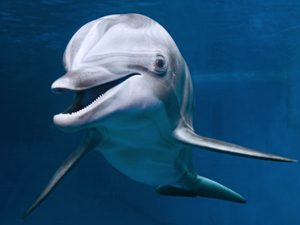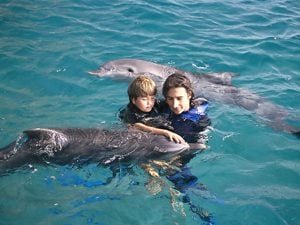Sorry: Dolphins Aren’t Smiling
Updated: Feb. 14, 2023
A dolphin's "smile" is actually an illusion. So is our belief that these animals can heal.

Vincent J. Musi/National Geographic Creative
JAY, AN EIGHT-YEAR-OLD boy with autism whose behavior has always been agitated and uncooperative, is smiling and splashing in a pool. A pair of bottlenose dolphins float next to him, supporting him in the water. Jay’s parents stand nearby as a staff member in the water engages Jay in games with colorful shapes. She asks him some questions, and the boy begins to respond. He names the shapes correctly, speaking his first words in months. Jay appears more aware and alert, and a quick, noninvasive scan shows that there have indeed been changes in his brain activity.
Jay’s parents are elated to have finally found a treatment that works for their son. They sign up for more sessions and can’t wait to get home and tell their friends about their experience. They’re not surprised to find that dolphins have succeeded where mainstream physicians have not. Everyone believes that dolphins are special—altruistic, extra gentle with children, good-natured. And the trainers have assured the parents that the dolphins are happy and accustomed to the role they’re playing. After all, as everyone can see, the dolphins are smiling.
Jay is a composite character drawn from the dozens of testimonials that appear on dolphin-assisted therapy (DAT) websites, but stories like his—about the extraordinary powers of dolphins—have been told since ancient times. Much of our attraction to these creatures derives from their appealing combination of intelligence and communication skills. However, their “smile,” which is not a smile at all but an anatomical illusion arising from the configuration of their jaws, makes people believe—wrongly—that the animals are always content.
Not only are the dolphins living in captivity unhappy, but there’s also no compelling evidence that they can heal. What does exist is a great deal of evidence that they are being harmed—along with the humans who believe in them.
Fuel for the Myth
The long-standing mythic belief in dolphins as healers has been passed down from the first written records of encounters with these animals. In Greco-Roman times, dolphins were closely linked with the gods. In Greek mythology, it’s said that Taras, son of Poseidon, was rescued from a shipwreck by a dolphin sent by his father. The perception of dolphins as lifesavers is connected with beliefs that they possess magical powers that can be used for healing. The ancient Celts attributed special abilities to dolphins, as did the Norse. Throughout time, people from Brazil to the Solomon Islands have traded dolphin body parts for medicinal and totemic purposes.
The person most responsible for advancing modern notions of dolphins as healers is the late neuroscientist John C. Lilly, who pioneered research with captive specimens in the 1960s. His early work on their brains and behavior was groundbreaking. In a paper published in Science in 1961, Lilly reported on the range of vocal exchanges between two dolphins in adjacent tanks and noted how their conversation followed polite rules. For example, when one spoke, the other was quiet. Lilly drew up a lexicon, showing that dolphins used a variety of communication methods, from blowing and whistling to clicking. But it was his informal studies of the mammals interacting with children with autism that led him to make statements about the animals’ powers, which became the basis for many of the claims made by DAT facilities.
Flipper Isn’t Real
Marine mammals were first captured for public display in the United States by circus mogul P. T. Barnum in the 1860s. Yet the popularity of dolphin shows, in which trainers engage them in daring gymnastics, grew dramatically in the 1960s and ’70s. In 1964, the TV series Flipper was first broadcast. Flipper was a bottlenose dolphin who lived in a cove and helped his two young human pals save people in trouble. But if Flipper increased public interest in dolphins, it also led to concerns over the animals’ welfare. So marine parks rebranded themselves as centers of conservation and learning—by emphasizing their breeding programs and efforts to educate people about marine animals—rather than as sites for entertainment.
Regardless, the public’s fascination with dolphins continues. In the United States alone, millions of people visit captive-dolphin facilities every year. Swimming with dolphins (SWD) programs have emerged as a lucrative component of the dolphin entertainment industry. Although some operations outside the United States offer opportunities to swim with wild dolphins, the large majority of SWD customers swim with captive dolphins in tanks or pools.
Many people describe their in-water encounter with a dolphin as one of the most exhilarating, transformative encounters of their lives. “This dolphin experience is life-changing. Never again … will I [have] a day like this,” writes Matt W. about his swim at the Dolphinaris park in Cancún, Mexico. Others report a sense of euphoria and intimate kinship with the animals. In many ways, it was only a matter of time before the concept of dolphin-assisted therapy emerged as an enhanced version of SWD programs, underpinned by theories of healing derived from dolphin mythology.

Jeffrey L. Rotman/Corbis
Dubious Benefits
Dolphin-assisted therapy typically involves several sessions of customers swimming or interacting with captive dolphins, along with performing more conventional therapeutic tasks such as puzzle solving and motor-skills exercises. The standard price of DAT sessions, whose practitioners are not required by law to receive any special training or certification, is steep, reaching into the thousands of dollars. It’s now a highly profitable business both inside and outside the United States, with facilities in countries including Mexico, Israel, Russia, Japan, China, and the Bahamas. DAT practitioners say that the sessions are particularly successful in treating depression and motor disorders in addition to childhood autism. But DAT can sometimes be less scrupulously advertised as being an effective treatment for everything from cancer to infections and developmental delays.
Even when they don’t promise an outright cure, DAT facilities market themselves as offering real therapy. They often use technology, like EEG to measure brain wave patterns, which suggests scientific legitimacy. But true therapy must have a relationship to a specific condition and result in quantifiable effects. While there are some published studies claiming to demonstrate positive results from DAT, few include a control group, which would help measure whether general, short-term results are due to interacting with the dolphins or caused by other factors, like being in the water, being given tasks, receiving increased attention from other people, or, of course, the placebo effect. Proponents of DAT cite anecdotal evidence and offer many reasons for its efficacy, from brain wave changes to the physiological effects of echolocation (dolphin sonar) on the human body.
The loved ones of children with autism and other people who appear to benefit from DAT tend to accept these explanations as scientifically plausible. And even those skeptical of DAT’s therapeutic abilities may shrug and ask, “What’s the harm if a child who typically experiences little enjoyment and accomplishment finds some happiness and connection with dolphins?” But the question usually left out is “What about the dolphins?”
Out of Their Depths
Decades of scientific research have confirmed that the mammals possess large, highly elaborate brains and prodigious cognitive capacities and engage in complex societies and even cultural traditions. Dolphins also have a level of self-awareness not unlike our own: They’re able to recognize themselves in a mirror, something only humans and primates are also able to do.
Hidden behind their “smiles,” however, captive dolphins spend their lives under tremendous stress, as they struggle to adapt to environments that—physically, socially, and psychologically—are different from the wild. In their natural habitats, dolphins may swim up to 100 miles a day and dive several hundred feet. They spend 80 to 90 percent of their time traveling below the surface. Contrast this with the shallow tanks—pools that may be only six feet deep and 24 feet long—filled with chlorinated water and devoid of plants, sand, and aquatic life that captive dolphins occupy.
The outcome of this treatment is devastating. Dolphins in the wild can live 30 to 50 years. According to a 2004 Sun Sentinel analysis of a few decades’ worth of federal documents of marine animals in captivity in the United States, more than half of the bottlenose dolphins that died during that period (and whose age was known) never reached the age of ten. Of the dolphins that are born into captivity in the United States, an estimated 60 percent pass away before their first birthday. Scientists have observed captive dolphins ramming into the sides of their tanks and chewing on the concrete until they’ve worn through their teeth. Often they die from gastric ulcers, infections, and other stress- and immune-related diseases.
The public is largely unaware of the consequences because aggressive or dying animals are often quietly replaced. (The original orca Shamu, for instance, spent just six years in captivity in SeaWorld in San Diego—in the wild, killer whales live 50 to 80 years—before dying in 1971. But the name Shamu has been used for different orcas in shows ever since, leading to the perception that the original Shamu is alive and well, enjoying his captivity.)
Dolphins aren’t the only ones harmed by dolphin-human contact. Because of their “smiles,” we forget that dolphins are predators and that they can be extremely aggressive. In the wild, they’ve been known to participate in brutal attacks on porpoises and, sometimes, their own young. Parents who would never place their child in a cage with a lion or an elephant seem to think nothing of placing them at very real risk—of injury and disease—in a tank with a dolphin. According to a National Marine Fisheries Service study of dolphin attractions, people have come out of their encounters with broken bones and lacerations. In December 2012, a dolphin in an SWD program in Cancún bit three people: a couple on their honeymoon and a middle-aged woman. The male victim compared it to a scene from Jaws, except with a dolphin.
Meanwhile, many parents bring their children with autism home after their DAT sessions and are disappointed when the kids withdraw again. At first, the fathers and mothers don’t want to consider that they could have wasted their time and money. But later they may acknowledge that not much has changed and that the benefits were due to the excitement of the trip and the attention their child received. Anthropologist Betsy Smith, who has been credited with creating dolphin therapy in the 1970s, stopped doing it in the 1990s and now calls it “the exploitation of vulnerable people and vulnerable dolphins.”
So what can be done? Several nations, like the United Kingdom, Australia, and India, prohibit keeping dolphins in captivity. Short of a ban, the public can campaign for the end of SWD programs (in the United States, swimming with dolphins in the wild is already illegal) and for a significant reduction in the number of dolphins in parks and other facilities. Dolphin therapy programs should be required to make their long-term results public so that families are able to decide—based on the statistics—whether to participate. Even with evidence debunking DAT, it’s understandable that desperate people will continue to turn to dolphins to find some help for their children. But they should know that the dolphins are suffering too.
Lori Marino is a neuroscientist at Emory University. She has been studying dolphins and whales for 25 years.